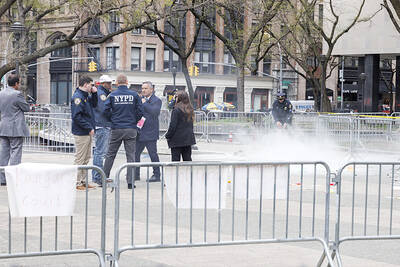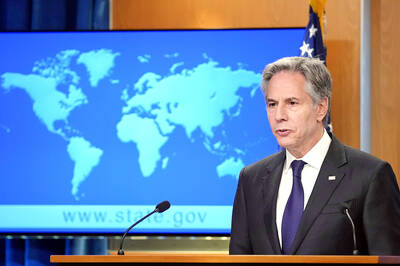Guatemalan security forces on Monday broke up a caravan of about 4,000 Honduran migrants trying to reach the US on a journey of thousands of kilometers through Central America on foot, Agence France-Presse (AFP) reporters witnessed.
Police advanced on the group in a coordinated move, striking batons against their shields to make an intimidating noise, prompting the migrants to scatter.
The group was still on Guatemalan soil, and some regrouped to resume their quest for a better life further north.
Thousands of others began returning to Honduras after clashing with the police.
Angie, a 21-year-old Honduran migrant, told AFP she was returning to Honduras to try and officially document her entry into Guatemala, as well as presenting a negative COVID-19 test, one of Guatemala’s requirements for crossing its borders.
“I want to continue to the United States; I don’t want to stay in Guatemala,” she said.
The caravan, which departed Honduras on Friday last week, has been held up since Saturday at the Guatemalan town of Vado Hondo, about 50km inside the border.
They have been waiting to pass, sleeping outdoors and blocking a key road where a massive logjam of cargo trucks has built up as a result.
As the migrants retreated before the advancing security forces on Monday, several threw stones at police.
The officers responded with tear gas, as they attempted to drive the group back toward the Honduran border, thus clearing the road for trucks.
Women carrying small children were among those to flee before the police.
“I am going with my son. In Honduras I have nowhere to live,” a woman told the Guatevision channel, catching her breath after a brisk run.
“If we had money, we would not be here heading north. They treat us like dogs, it should not be like this,” said another woman, holding a small girl.
On Sunday, the group was confronted by police and soldiers with tear gas and batons under strict orders to stop anyone without travel documents or a negative COVID-19 test from going any further.
Several migrants were injured in Sunday’s clashes, a health worker said.
About 9,000 migrants have set out from Honduras since Friday.
On Monday, Guatemalan migration authorities said more than 1,500, including 208 children, had since returned to Honduras. About 800 people were stuck in a town neighboring Vado Hondo.
Those determined to stay the course, including families with young children, spent a second chilly night outdoors on Sunday.
They slept on the asphalt road or on patches of grass, the lucky ones wrapping up in blankets, the rest donning sweaters or long-sleeved T-shirts packed among their sparse belongings.
Nearly half of China’s major cities are suffering “moderate to severe” levels of subsidence, putting millions of people at risk of flooding, especially as sea levels rise, according to a study of nationwide satellite data released yesterday. The authors of the paper, published by the journal Science, found that 45 percent of China’s urban land was sinking faster than 3mm per year, with 16 percent at more than 10mm per year, driven not only by declining water tables, but also the sheer weight of the built environment. With China’s urban population already in excess of 900 million people, “even a small portion

UNSETTLING IMAGES: The scene took place in front of TV crews covering the Trump trial, with a CNN anchor calling it an ‘emotional and unbelievably disturbing moment’ A man who doused himself in an accelerant and set himself on fire outside the courthouse where former US president Donald Trump is on trial has died, police said yesterday. The New York City Police Department (NYPD) said the man was declared dead by staff at an area hospital. The man was in Collect Pond Park at about 1:30pm on Friday when he took out pamphlets espousing conspiracy theories, tossed them around, then doused himself in an accelerant and set himself on fire, officials and witnesses said. A large number of police officers were nearby when it happened. Some officers and bystanders rushed

HYPOCRISY? The Chinese Ministry of Foreign Affairs yesterday asked whether Biden was talking about China or the US when he used the word ‘xenophobic’ US President Joe Biden on Wednesday called for a hike in steel tariffs on China, accusing Beijing of cheating as he spoke at a campaign event in Pennsylvania. Biden accused China of xenophobia, too, in a speech to union members in Pittsburgh. “They’re not competing, they’re cheating. They’re cheating and we’ve seen the damage here in America,” Biden said. Chinese steel companies “don’t need to worry about making a profit because the Chinese government is subsidizing them so heavily,” he said. Biden said he had called for the US Trade Representative to triple the tariff rates for Chinese steel and aluminum if Beijing was

Beijing is continuing to commit genocide and crimes against humanity against Uyghurs and other Muslim minorities in its western Xinjiang province, U.S. Secretary of State Antony Blinken said in a report published on Monday, ahead of his planned visit to China this week. The State Department’s annual human rights report, which documents abuses recorded all over the world during the previous calendar year, repeated language from previous years on the treatment of Muslims in Xinjiang, but the publication raises the issue ahead of delicate talks, including on the war in Ukraine and global trade, between the top U.S. diplomat and Chinese